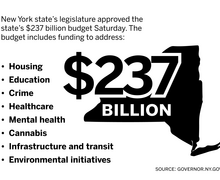A home of their own: University-area neighborhoods see increase in landlord-owned houses
Zixi Wu | Staff photographer
Corrie Raulli sits with her two children on the porch of their home on Livingston Avenue. The Raullis are among the few residents on the street who own the home they live in. The number of owner-occupied homes in the East Neighborhood has declined recently as landlords buy houses to rent to students.
Beer cans scattered over unkempt lawns, bikes locked onto porches and the occasional funnel hanging over a balcony set the scene on Livingston Avenue.
But sometimes, tucked away from the wild, off-campus student lifestyle, exists the rare, well-maintained house of a Syracuse family.
Corrie Raulli, a homeowner on the 800 block of Livingston Avenue and a Syracuse native, is one of few local residents in the East Neighborhood, an area right off campus predominately occupied by students.
“When we moved to this house five years ago, we knew what we were getting ourselves into,” Raulli said. “For the most part, our various student neighbors have been respectful of our property and the fact that we have small children.”
Livingston Avenue has reached a crucial tipping point in the balance between owner-occupied and landlord-owned homes.
“We are one of the few streets left around here with a 50-50 split,” Raulli said. “We are at the point where if one more home is bought out by a landlord, it will disrupt this balance.”
Many of these landlord-owned homes attract Syracuse University students who rent out houses for the school year, creating a diverse neighborhood demographic.
Overall, Raulli said she enjoys the company of her student neighbors; some have even helped babysit her two kids. While she admitted that some of the loud parties at 2 a.m. and excessive pedestrian traffic can grow old quickly, she said she didn’t find student presence to be a main concern.
Rauli does, however, worry about the increasing number of landlords buying out houses that were once owner-occupied.
The University Neighborhood Preservation Association is a local nonprofit organization taking direct measures to combat this problem. The organization’s mission is promoting homeowner occupancy, said Rebecca Shaffer Mannion, executive director of UNPA.
The organization works closely with homeowners and landlords to keep houses in UNPA’s designated target area owner-occupied, Mannion said.
This target area includes the neighborhoods bordered by Comstock Avenue on the west, East Colvin Street on the south, East Genesee Street on the north and Cumberland Avenue on the east, according to the UNPA website.
“Basically neighborhood groups contact us for assistance,” Mannion said. “We offer incentives like a homebuyer’s assistance program or a low-interest home improvement loan to attract new owners or keep homeowners in place.”
UNPA has partnered with two nonprofit community development groups, Empire Housing & Development Corp. and Home HeadQuarters, to purchase and rehabilitate homes within the organization’s target area and maintain homeowner presence, she said.
For example, Mannion said, Home HeadQuarters’ affiliate, CNY Affordable Realty, purchased a home at 101 Berkeley Drive and maintained it until an owner-occupant was found. Empire Housing & Development also worked to keep a home at 104 Buckingham Ave. owner-occupied.
Karen Schroeder, resource development and government relations manager for Home HeadQuarters, said the nonprofits face the biggest challenges when owner-occupied homes go up for sale. Individuals trying to purchase homes have more financial strain than companies investing.
“Potential owner-occupants cannot compete with big money investors when it comes time to purchase the home,” she said. “This is where we try to step in.”
The role of Home HeadQuarters is not to turn over longtime investor-owned homes, Schroeder said, but to keep longtime owner-occupied houses in the hands of homeowners and to promote affordability.
Home HeadQuarters and UNPA have worked together on other projects as well, Schroeder said. The two groups worked on funding several housing plans and renovations through the Rescue a Rental Program, which offers up to $4,500 in homebuyer’s assistance, she said.
While Home HeadQuarters works with other neighborhood groups and housing organizations in Central New York, UNPA’s sole is its target area east of SU’s campus. There is a different kind of focus on the historic neighborhood, Schroeder said.
“UNPA’s target neighborhood is a little different than other neighborhoods in the city of Syracuse,” Schroeder said. “Many properties in that neighborhood are more like businesses: private owners looking to make a bit of income through renters.”
About 6,000 students live in this designated target area, said Elin Riggs, director of off-campus and commuter services at SU.
“I think, generally speaking, the long-term residents don’t mind having the students around,” she said. “There are just some of the residual effects including parties, noise and unsightliness that frustrates neighbors.”
When houses go up for sale, the long-term residents know about it and try to ensure the home goes to an owner-occupant instead of a landlord, Riggs said.
But the students aren’t the major concern of homeowners. Neighborhood groups and homeowners worry most about long-term consequences to infrastructure as investor-occupied housing booms, said Raulli, the homeowner.
“The sewers and pipes were never zoned for this kind of activity,” Raulli said. “Some of the rental houses are not as well kept up as owner-occupied houses and are even sometimes dangerous. I wish students would boycott some of these houses.”
Though some local residents have moved out, Raulli is adamant about staying put.
“We moved to this neighborhood to be in an urban environment,” she said. “The convenience of living here is fantastic, but I hope we can stop the bleeding and retain some of the long-term owner-occupied houses in the future.”
Published on December 4, 2012 at 3:02 am
Contact Levi: [email protected]




